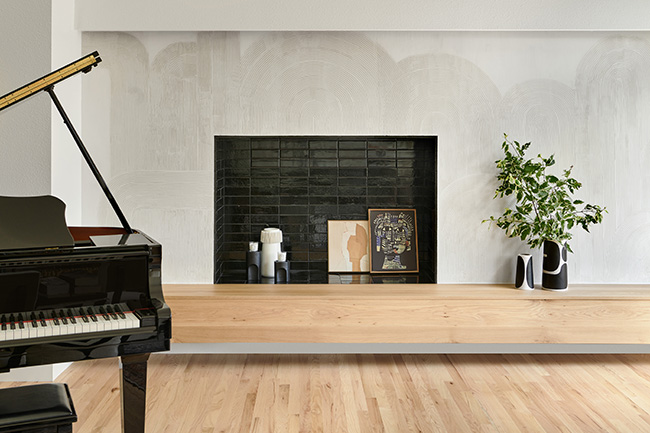Wild, Whimsical, Wonderful
13 Oct 2014
Jean Morgan’s Louisville garden is a combination of all three, as well as a testament to local history and a nod to butterflies, bees, birds and moths.
By Lisa Marshall In an age when the average U.S. single-family home is 2,600 square feet and the typical yard is a blanket of thirsty grass, Jean Morgan’s flower-studded miner’s shack on the outskirts of Old Town Louisville provides a refreshing portal into a simpler time. “I have the littlest house on the smallest lot on the shortest street in town,” she proudly says as she tours a visitor around her historic 900-foot abode and the postage-stamp lot she’s transformed into an eye-popping spectacle of color over the past 43 years. In this case, the gardener is as colorful as the garden. She’s clad in a vintage pink-and-white checkered shirt, white capris, and sandals that show off a slightly faded honeybee tattoo. Her eyes are impossibly blue and the curls beneath her black sun visor are golden blonde, making it tough to determine her age (which she politely declines to share). But her wild, whimsical garden reveals the story of a long, rich life and a deep reverence for those who came before her.
“People have given me so many plants over the years,” she says, pointing to a patch of coral-colored hens and chicks her neighbor Gracie gave her back in the ’70s, a stand of red roses her late husband gave her in the ’80s, and a weathered wagon donated by a friend. “You look at all these things and you think of those people. It’s delightful.”
The home, designated a historic landmark in 2013 by the Historic Preservation Commission, was built in 1942 by a Hungarian coal miner named Joe Restas.
As the story goes, Restas asked the landowner if he could build a cabin on a 25-foot-wide sliver at the edge of his large lot. The landowner kindly obliged and Restas got to work, erecting a 225-square-foot house with a 210-square-foot attached garage that extended slightly (about 3 feet) past the 25-foot boundary he was allowed. (The owners let it slide.) “I’m sure he just stepped that 25 feet off,” guesses Morgan as she lovingly flips through old pictures of the shack’s early days. “Can’t you just see these guys out there in their bib overalls stepping it off?”
Morgan and her then-husband Tom arrived in the Miner’s Field neighborhood a quarter-century later, renting an apartment catty-corner from the Restas house for about 80 bucks a month, working as schoolteachers, and getting to know and love the many old-time miners living out their days there.
[pp_gallery gallery_id="10110" width="180" height="180"]“I used to see Joe walking uptown. He was very slight,” Morgan recalls, wishing she’d known him better in his younger, healthier days. When Restas moved into a local nursing home, Morgan brought him pasta from the nearby Blue Parrot and homemade pizzelle cookies.
When he passed away and his house came up for sale in the early ’70s, she bought it, converting the tiny, low--ceilinged garage into a bedroom for a grand total living space of 435 feet. She raised bees for honey and chickens for eggs in the backyard (the city later shut her down because of a livestock ordinance), but in those early days there was no money to buy plants.
“When we were first married I would buy a can of tomato soup for 14 cents and Tom would grab some crackers and that would be our dinner,” she recalls. “We had nothing. Gracie would give me whatever extra plants she had and I would stick them in the ground.” So did the sweet old gal down on the corner, and the friendly old-timer up the road, and soon her barren patch of dirt was shaping up to be something quite extraordinary. As they traded plants and stories over the fence, Morgan learned a lot about Louisville’s history.
“You know they used to call this place Liquorville,” she whispers with a chuckle. “Louisville was wet when Boulder was dry, so all the students would come here.” After she and Tom divorced, Morgan remained, adding a modest living room to the house in the ’80s and spending much of her free time hands-deep in the soil.
[pp_gallery gallery_id="10081" width="180" height="180"]
In this case, the gardener is as colorful as the garden. She’s clad in a vintage pink-and-white checkered shirt, white capris, and sandals that show off a slightly faded honeybee tattoo. Her eyes are impossibly blue and the curls beneath her black sun visor are golden blonde, making it tough to determine her age (which she politely declines to share). But her wild, whimsical garden reveals the story of a long, rich life and a deep reverence for those who came before her.
“People have given me so many plants over the years,” she says, pointing to a patch of coral-colored hens and chicks her neighbor Gracie gave her back in the ’70s, a stand of red roses her late husband gave her in the ’80s, and a weathered wagon donated by a friend. “You look at all these things and you think of those people. It’s delightful.”
The home, designated a historic landmark in 2013 by the Historic Preservation Commission, was built in 1942 by a Hungarian coal miner named Joe Restas.
As the story goes, Restas asked the landowner if he could build a cabin on a 25-foot-wide sliver at the edge of his large lot. The landowner kindly obliged and Restas got to work, erecting a 225-square-foot house with a 210-square-foot attached garage that extended slightly (about 3 feet) past the 25-foot boundary he was allowed. (The owners let it slide.) “I’m sure he just stepped that 25 feet off,” guesses Morgan as she lovingly flips through old pictures of the shack’s early days. “Can’t you just see these guys out there in their bib overalls stepping it off?”
Morgan and her then-husband Tom arrived in the Miner’s Field neighborhood a quarter-century later, renting an apartment catty-corner from the Restas house for about 80 bucks a month, working as schoolteachers, and getting to know and love the many old-time miners living out their days there.
[pp_gallery gallery_id="10110" width="180" height="180"]“I used to see Joe walking uptown. He was very slight,” Morgan recalls, wishing she’d known him better in his younger, healthier days. When Restas moved into a local nursing home, Morgan brought him pasta from the nearby Blue Parrot and homemade pizzelle cookies.
When he passed away and his house came up for sale in the early ’70s, she bought it, converting the tiny, low--ceilinged garage into a bedroom for a grand total living space of 435 feet. She raised bees for honey and chickens for eggs in the backyard (the city later shut her down because of a livestock ordinance), but in those early days there was no money to buy plants.
“When we were first married I would buy a can of tomato soup for 14 cents and Tom would grab some crackers and that would be our dinner,” she recalls. “We had nothing. Gracie would give me whatever extra plants she had and I would stick them in the ground.” So did the sweet old gal down on the corner, and the friendly old-timer up the road, and soon her barren patch of dirt was shaping up to be something quite extraordinary. As they traded plants and stories over the fence, Morgan learned a lot about Louisville’s history.
“You know they used to call this place Liquorville,” she whispers with a chuckle. “Louisville was wet when Boulder was dry, so all the students would come here.” After she and Tom divorced, Morgan remained, adding a modest living room to the house in the ’80s and spending much of her free time hands-deep in the soil.
[pp_gallery gallery_id="10081" width="180" height="180"]












